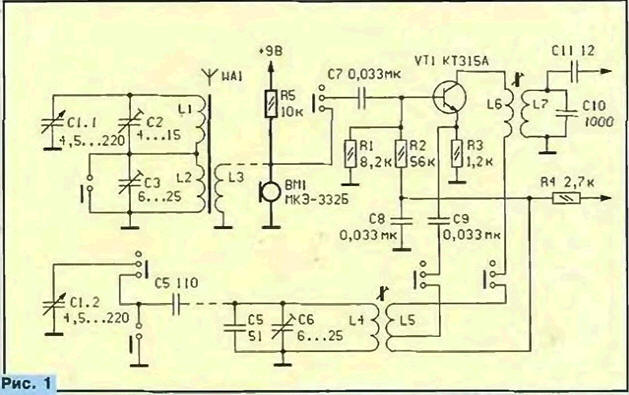To listen to a radio program, a person with impaired hearing need receiver with head phones, and to communicate freely with others not do without a hearing aid. To have at itself both device, switching the headset from one to the other rather inconvenient. For combining both functions in a single device some ham radio operators (see, for example, article V. Petrova in "Radio", 1997, № 1, p. 21) build a receiver direct amplification with switch, allowing the choice to attach to node USC the reception of radio signals or microphone.
Such problem can be solved easier and faster if you use the factory dual band superheterodyne previous releases. In this case, in one position the transmission range switch device will operate in the normal reception mode radio (medium wave) and the other to amplify signals of audio frequency, coming from the microphone. Thus amplifying properties are used not only USC, but also radio-frequency stages. The essence of the latter is that heterodyne one band (e.g., far) are gearing up to a fixed frequency equal to the intermediate and preselector LW is "off" from Converter and replaced the chain with the included microphone.
Input Converter (see picture) audio signals modulate oscillations of intermediate frequency that can pass through the filter focused selection (FSS), tuned to a frequency of 465 kHz, amplified in the cascades of the Commissioner, and after the usual detection in USC. Such a construction of the sound channel allows you to get more gain than one USC and to use the AGC action.

The figure shows a fragment of the model to the input part and inverter circuits range LW (receiver "Gauja", the default scheme, with an earlier revision receiver were used effect transistors n-p-n, changed the polarity the inclusion of capacitors and diodes, powered with grounded minus the current source). In two places, the dashed line marked gaps in staffing circuits that are performed by the cutting of the foil traces. Again the input circuit elements and circuits are highlighted with thicker lines.
What guides the restructuring of the local oscillator frequency? It is known that in LW the lower frequency of 615 kHz. Hence, the required ratio lowering the frequency will be K = 615/465 =1,32. Without touching the contour coil L4 (her inductance 580 mH), will require K2 = 1.75 times increase the capacity capacitor heterodyne circuit (including the capacity of the installation). We change staffing on capacitor C5 capacitor with a larger capacity (instead of the capacitor capacitance 25 pF should adopt the same 51 pF).
Then, breaking the wire that goes from the transmission range switch to the coil L3 communications with the aerial circuit LW, you must attach the microphone circuit and additional VM resistor R5 for connection with the power circuit of the receiver. The latter is necessary to work the microphone is an electret type (MKE-B). The microphone can be placed near dynamic head.
Following completion, proceed to the adjustment of the additional elements. To do this, connect to the receiver head phone and install the switch the ranges in the "LW" and include meals. Next to the receiver to place the source of the sound, for example, loudspeaker broadcasting, working with a low level of sound. Rotating the rotor rigged capacitor C6, in one point you can hear the program wired broadcasting. The correctness settings is controlled by the maximum volume in the head the phone - in this case, the frequency of the modernized lo will be exactly be consistent with the existing set of contours FSS - last to touch in no if you cannot avoid detuning of the channel interference. If adjustment the capacitor C6 is somewhat rough, more accurate adjustment can be made the podstroechnik coil L4 by turning it no more than one turn. If podstroechnik has to rotate more, we recommend you change the capacity capacitor C5 to the nearest in a series of nominal values and repeat adjustment.
Schemes other receivers may have some differences from the one shown, but the principles of revision are the same. Receivers with one range, and as models with shared none-switchable coil connection with the aerial contours of the two ranges can be converted without introducing additional switches only in the hearing with loss of function of radio. However, the need to strengthen audibility of the interlocutor is sometimes more important and here the method proposed alteration will be useful.
Author: Yu Prokopcov, Moscow






